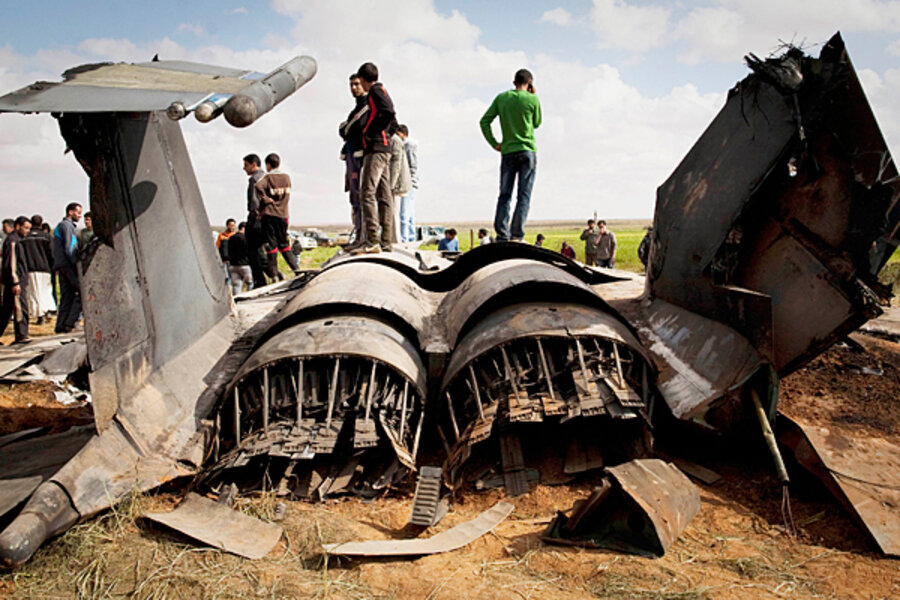American F-15 crashes in Libya, a reminder of mission's potential costs
Loading...
| Washington
Two American pilots were forced to eject from their F-15 fighter jet Monday night after the aircraft experienced “equipment malfunction” over northeast Libya, according to a statement released Tuesday by the US military task force in charge of Libyan operations.
The military dispatched two Marine Osprey tilt-rotor aircraft from the amphibious assault ship USS Kearsarge, which is currently about 100 miles off the coast of Libya, to pick up one of the downed pilots. The other ejected and “was recovered by the people of Libya,” said Adm. Samuel J. Locklear III, commander of US Naval Forces in Europe and Africa. “He was treated with dignity and respect, and is now in the care of the United States.”
Both sustained only minor injuries, according to Admiral Locklear.
The jet, based out of Lakenheath, England, went down over eastern Libya Monday at 10:30 p.m. “while conducting a strike mission against Qaddafi regime air defense systems,” according to a statement released by the US military’s Africa Command.
The implications of the downed US fighter jet go beyond the mechanical, however. “The crash demonstrates the real and potential costs of the operation,” says Richard Fontaine, an analyst with the Center for a New American Security.
Locklear acknowledged this in a Pentagon briefing Tuesday with reporters. “We all know military operations are inherently dangerous,” he said.
If the crew members had been captured by pro-Qaddafi forces, Mr. Fontaine notes, the situation would have had the potential to be vastly more damaging to coalition operations in Libya.
Rumors, however, continued to circulate about the operation. Locklear would not comment on British news reports that the Marine Osprey charged with rescuing one of the downed pilots may have opened fire on villagers during the rescue mission, saying the investigation remains ongoing.
“I’m not prepared to talk about what that investigation may or may not reveal,” he said. The recovery mission “was executed as I would have expected it to be given the circumstances.”
He added, “We’re in the middle of a major operation out here. … This investigation will take time and will be looked at very carefully.”
As it stands now, the no-fly zone has rendered Qaddafi’s air force “largely ineffective,” Locklear said. To date there hasn’t been “any significant movement” among Libyan aircraft, which Locklear said is a “good indication that our air strikes were effective.”
Rendering Qaddafi’s air force ineffective was not a difficult prospect for the US military, according to senior US military officials. Qaddafi’s air force “was generally not in good repair compared to what you consider the world standard” of air forces might be, Locklear said. “A lot of equipment” was “aged, sitting on runways and could not be used.”
Qaddafi’s ground forces, however, remain another matter. These forces “are still not in compliance” with the UN resolution, Locklear said, adding that the coalition has launched “information operations” campaigns – formerly known as psychological warfare – to encourage Qaddafi’s forces to stand down. He did not elaborate on what those measures might be. In the past they have involved mass leafleting, which might tell Libyan troops that if they point their tanks in a particular direction – often in a direction of retreat, for example – they would not be harmed.
Yet many Libyan forces remain loyal to Qaddafi, and protecting civilians in towns like Misrata remains a vexing problem for the US military, given the close proximity between Qaddafi’s forces and the civilians they could potentially harm, says Locklear.
“We’re aware of the difficulties of that situation, we’re aware of what we believe the intelligence situation in the city is,” he told reporters in response to a question about how best to avoid harming civilians in the midst of urban warfare.
Locklear said he had no estimate on precisely when the Libyan operation, which the US military has dubbed Joint Task Force Odyssey Dawn, would transition from US control to that of another coalition member. The transition is “something I’m not focusing on out here,” he said, adding that it is “for political leadership to decide.”





